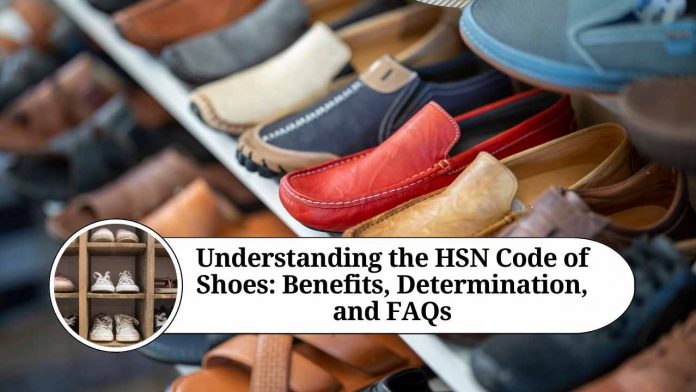Understanding HSN Code of Shoes: A Comprehensive Guide
The Harmonized System of Nomenclature (HSN) is an internationally recognized classification system used for the systematic classification of goods. The HSN code is a six-digit code that classifies products based on their nature, form, and use. In this blog, we will discuss the HSN code of shoes and how it works.
What is the HSN code of shoes?
The HSN code of shoes is 64. The code covers all types of shoes, including leather shoes, sports shoes, sneakers, sandals, and other types of footwear. The HSN code of shoes is used for various purposes, including import/export, taxation, and trade statistics.
How is the HSN code of shoes determined?
The HSN code of shoes is determined based on various factors, including the material used to make the shoes, the purpose of the shoes, and the type of shoes. Here is a breakdown of the HSN code of shoes:
- Leather shoes: The HSN code for leather shoes is 6403. This includes shoes made of leather or composition leather, such as dress shoes, loafers, and formal shoes.
- Sports shoes: The HSN code for sports shoes is 6404. This includes shoes designed for sports activities, such as running shoes, tennis shoes, and basketball shoes.
- Sneakers: The HSN code for sneakers is 6405. This includes shoes that have a flexible sole made of rubber or synthetic material and an upper part made of fabric or leather.
- Sandals: The HSN code for sandals is 6402. This includes shoes that have an open toe and open heel, such as flip flops, slides, and gladiator sandals.
- Other types of shoes: The HSN code for other types of shoes is 6406. This includes shoes that do not fall under any of the above categories, such as boots, clogs, and slippers.
Why is the HSN code of shoes important?
The HSN code of shoes is important for various reasons, including:
- Customs clearance: When importing or exporting shoes, the HSN code is used to determine the customs duty applicable to the shoes.
- Taxation: The HSN code is used to determine the tax rate applicable to the shoes under the Goods and Services Tax (GST).
- Trade statistics: The HSN code is used to compile trade statistics related to the import and export of shoes.
Benefits of using the HSN code of shoes
There are several benefits to using the HSN code of shoes, including:
- Accurate classification: The HSN code of shoes provides an accurate classification of footwear, which can help importers, exporters, and manufacturers identify the appropriate duty rates, taxes, and other regulatory requirements for their products.
- Improved trade facilitation: The HSN code of shoes promotes trade facilitation by providing a common language for the classification of footwear. This enables smoother customs clearance and reduces the risk of delays or errors.
- Better compliance: By using the correct HSN code of shoes, importers and exporters can ensure compliance with customs and regulatory requirements. This reduces the risk of penalties or fines for non-compliance.
- Enhanced transparency: The HSN code of shoes enhances transparency in trade by providing a standardized system for the classification of footwear. This enables better tracking and monitoring of trade flows, which can help governments and businesses make more informed decisions.
How to determine the HSN code of shoes?
To determine the HSN code of shoes, you will need to consider several factors, including the material used to make the shoes, the purpose of the shoes, and the type of shoes. Here are some guidelines to help you determine the HSN code of shoes:
- Identify the material used: Determine if the shoes are made of leather, synthetic materials, or other materials.
- Determine the purpose of the shoes: Determine if the shoes are designed for sports activities, formal occasions, casual wear, or other purposes.
- Identify the type of shoes: Determine if the shoes are boots, sneakers, sandals, dress shoes, or other types of footwear.
Once you have determined the material, purpose, and type of shoes, you can refer to the HSN code list to identify the appropriate code for your product.
Conclusion
In conclusion, the HSN code of shoes is an important classification system that is used for the systematic classification of footwear. It is important for importers, exporters, and manufacturers of shoes to be aware of the HSN code of shoes and its implications for customs clearance, taxation, and trade statistics. By using the correct HSN code of shoes, businesses can improve compliance, trade facilitation, and transparency, which can ultimately lead to greater success in the global market.
Read more useful content:
Frequently Asked Questions (FAQs)
What is the purpose of the HSN code of shoes?
The HSN code of shoes is used for the systematic classification of footwear for various purposes, including customs clearance, taxation, and trade statistics.
What are the different types of shoes covered under the HSN code?
The HSN code of shoes covers various types of footwear, including leather shoes, sports shoes, sneakers, sandals, boots, clogs, and slippers.
How is the HSN code of shoes determined?
The HSN code of shoes is determined based on several factors, including the material used to make the shoes, the purpose of the shoes, and the type of shoes.
Do I need to use the HSN code of shoes for all types of footwear?
Yes, the HSN code of shoes should be used for all types of footwear to ensure accurate classification and compliance with customs and regulatory requirements.
What are the benefits of using the HSN code of shoes?
The benefits of using the HSN code of shoes include improved accuracy in classification, better trade facilitation, enhanced compliance, and greater transparency in trade flows.
How can I determine the correct HSN code of shoes for my product?
To determine the correct HSN code of shoes for your product, you should consider the material used, the purpose of the shoes, and the type of shoes. You can refer to the HSN code list to identify the appropriate code for your product.
Do different countries use the same HSN code for shoes?
Yes, the HSN code is a standardized classification system that is used by countries around the world to classify goods.
What is the importance of accurate classification of footwear?
Accurate classification of footwear is important for ensuring compliance with customs and regulatory requirements, avoiding penalties or fines for non-compliance, and improving trade facilitation.
How can I learn more about the HSN code of shoes?
You can learn more about the HSN code of shoes by referring to the official HSN code list or by consulting with a customs broker or trade expert.
Can the HSN code of shoes change over time?
Yes, the HSN code of shoes may change over time based on updates to the classification system or changes in the nature, form, or use of footwear.




















